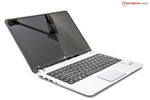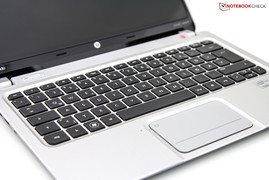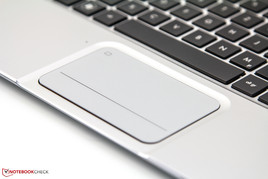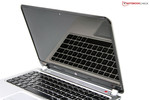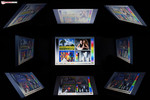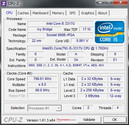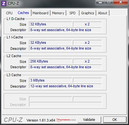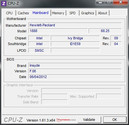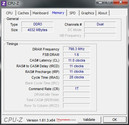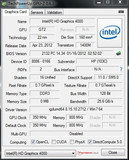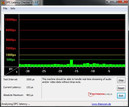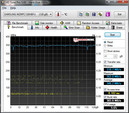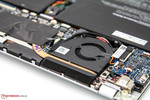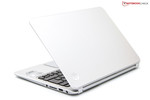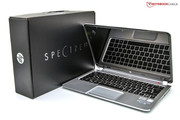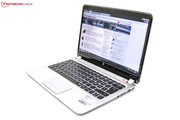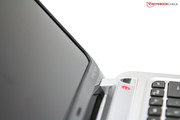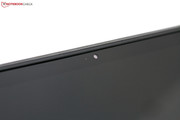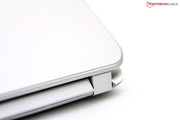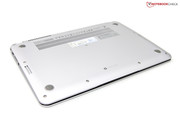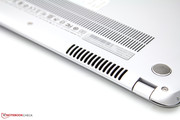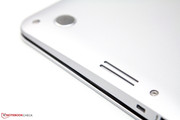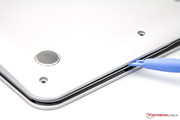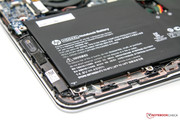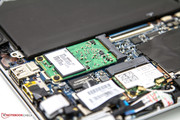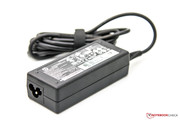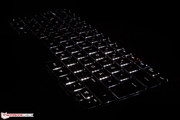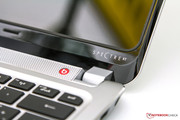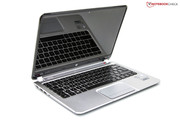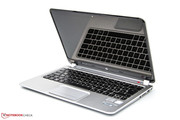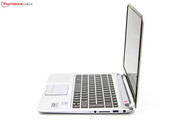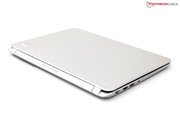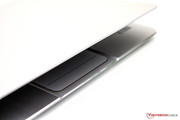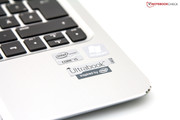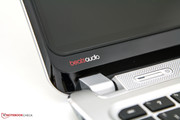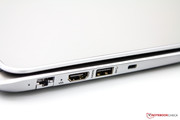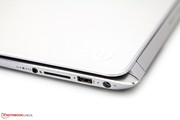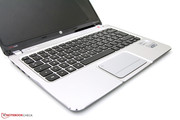Review HP Envy Spectre XT 13-2000eg Ultrabook

With the Envy Spectre XT 13-2000eg, Hewlett-Packard (HP) has increased its ultrabook offerings. This notebook features a glossy 13.3-inch display with a standard resolution of 1366x768. With a weight of 1.41 kilograms (3.10 pounds), the ultrabook is targeted toward customers seeking a sleek design and superior workmanship. Important aspects of the premium package are the all-metal design and brushed aluminum surfaces. Other contenders amongst the top tier of ultraportable notebooks are the MacBook Air 13 (Mid-2012) and the Asus Zenbook Prime UX31A.
For the Spectre XT 13-2000eg, HP used the middle-of-the-line Intel Core i5-3317U dual-core processor with a base clock of 1.7 GHz. The processor-integrated Intel HD Graphics 4000 GPU handles graphical tasks and rendering. The hardware package is rounded out by 4 GB of DDR3 RAM, a 128 GB SSD, current-generation wireless modules, and the widely advertised Beats Audio speakers. In Germany, this system carries a retail price of 999 Euro (~$1249). In this review, we consider whether this notebook is a well-rounded option for the demanding customer or merely a case of more style than substance.
Case
The HP Envy Spectre XT 13 uses a case that definitely bears an eye-catching design. Unlike Apple and Asus, HP does not use a one-piece aluminum unibody case but rather combines a brushed aluminum keyboard area and display lid with a soft-touch magnesium alloy base unit and a glossy plastic display bezel. The mix of black and silver is both modern and timeless. We rather liked the visual impact of the notebook which is accentuated by the case’s angular, wedge-shaped case.
The case presented a good impression in terms of build quality. We found no uneven gaps and transitions between the different materials of the case were smooth and clean. However, the base unit did deform somewhat when pressure was applied but we did not feel this would be noticeable in everyday use. The display lid is not particularly torsionally rigid but did not creak when twisted. The hinges are sufficiently stiff but we noticed that the display lid did sway slightly after an adjustment. While the battery is placed toward the front end of base unit, the notebook still moved slightly when opening the display lid and the base unit required being held down.
Weight, including the battery, is a very important factor for devices in this class. The Spectre XT tipped the scales at 1.41 kilograms (3.10 pounds) representing an average weight. By comparison, the Asus Zenbook Prime UX31A weighs roughly the same but the Toshiba Satellite Z930 is much lighter at 1.09 kilograms (2.40 pounds). At 1.35 kilograms (2.98 pounds), the Apple MacBook Air 13 (Mid-2012) is only marginally lighter than our test system.
Connectivity
The HP Envy Spectre XT 13 features the most frequently used ports on the left and right sides of the ultrabook, including a USB 3.0 port, an HDMI out port for external displays, and an RJ-45 network jack for wired communication. Not all notebooks in the ultrabook class include the latter due to their slim designs. A card reader, audio combination jack, and one additional USB port complete the included interfaces. While we liked both the distribution and positioning of ports, we would have preferred that HP included an additional USB port.
Communication
The Envy Spectre XT 13 includes communications options that we have come to expect from any ultrabook. The HP ultrabook includes Gigabit Ethernet and 802.11a/b/g/n Wi-Fi for network connectivity. An Intel module also provides support for Bluetooth 4.0. Due to the use of an Intel Ivy Bridge Core i5 processor, the Envy Spectre XT also features support for Intel Wireless Display (WiDi). When paired with a separately purchased receiver unit, this technology allows display contents to be wirelessly transmitted to external displays that can accept an HDMI connection. This consumer-based ultrabook does not include an integrated UMTS (Universal Mobile Telecommunications System) module and there is no slot for such a module. The built-in 720p webcam features an integrated microphone and offers decent quality.
Accessories
The Envy Spectre XT 13’s retail package did not include any surprises. Aside from the notebook, its power adapter, and two brief information pamphlets, HP only provides a sleeve for the ultrabook that is made from a velvety material. As the sleeve is not padded, we doubt its suitability for protecting the ultrabook from the rigors of daily use. In terms of pre-installed software, HP managed to differentiate the ultrabook from competitors by including Adobe Photoshop Elements 10, a photo-editing program that typically retails for approximately 60 Euro (~$75), and a full two-year version of Norton Internet Security 2012. As with most other notebooks, Microsoft Office 2010 Starter Edition is also included.
Maintenance
As the HP Envy Spectre XT 13 has no maintenance cover, user access to the notebook’s components is restricted. In order to access these components, the entire bottom plate must be removed. The process of separating the two halves of the ultrabook’s underside is very difficult without the use of a special plastic tool. We found that it is exceedingly easy to damage the case without this tool and we at Notebookcheck.net cannot assume any liability for users attempting to disassemble their ultrabooks. That said, access is not necessary considering the included hardware. The RAM is soldered directly onto the motherboard and the mSATA SSD is not a standard 2.5-inch drive. Theoretically the fan and lithium-ion battery could be removed but it would be a much better idea to let an authorized service provider conduct this level of service.
Warranty
HP provides a two-year warranty with pick-up service for the Envy Spectre XT 13. This warranty also covers the integrated battery. The included power adapter carries a twelve-month warranty. We found information on the HP website regarding an extension of the warranty to a 36-month term (under reference code UM947E) but were unable to find a price for this extension.
Input Devices
Keyboard
The Envy Spectre XT 13’s chiclet-style keyboard fits well with the overall look of the ultrabook. The individual keys allow for quick acclimation to the keyboard itself. The keys protrude slightly, feature decent travel, and have a distinct feedback. The typing noise was rather low in frequency and did not become annoying even after extensive periods of typing. The large right Shift key and the pleasant labeling of the keys certainly help ergonomics.
While backlit keyboards were once limited to high-end notebooks, more and more notebooks have joined the trend recently and the Envy Spectre XT 13 is no exception. While the brightness levels are limited to a simple on/off toggle, the illumination was subjectively pleasant. The backlight is enabled and disabled through the use of the F5 function key. On the subject of function keys, F1 through F12 require pressing the Fn key. All things considered, we liked the keyboard.
Touchpad
The touchpad of the HP Envy Spectre XT 13 rests slightly elevated in a recessed area of the wrist rest that is slightly larger than the touchpad itself. With dimensions of 92 x 57 millimeters (3.8 x 2.2 inches), the surface is sufficiently large. The touchpad supports multi-touch gestures and allowed for easy gliding. The integrated mouse buttons are separated from the main touch surface by a line. On the upper left, there is also a switch to enable and disable the touchpad. It usually took us a few tries to properly toggle the state as indicated by an accompanying LED on the left. It might have been better to implement this toggle using a keyboard shortcut instead.
Display
The Envy Spectre XT 13 ultrabook is equipped with a glossy 13.3-inch screen (33 centimeter diagonal) which uses a standard resolution of 1366x768 in a 16:9 aspect ratio. We found no options for a higher resolution or a matte display. By comparison, the HP Folio 13 Ultrabook is offered with a matte screen and the 13.3-inch Asus Zenbook Prime UX31A uses a Full HD 1920x1080 display and costs only slightly more. As the Spectre XT 13 includes an HDMI out, the ultrabook can be easily connected to an external monitor or TV. We tested the ultrabook’s HDMI output and found no issues with signal quality.
To determine the display’s brightness, we used the Gossen Mavo-Monitor tool. We recorded an average brightness of only 190 cd/m2 for the LGD0368 display panel, representing a middle-of-the-road performance at best. While the brightness distribution of 88 percent was rather even, we felt that the offered resolution and the brightness value are below the mark for a premium ultrabook.
| |||||||||||||||||||||||||
Brightness Distribution: 88 %
Center on Battery: 201 cd/m²
Contrast: 161:1 (Black: 1.25 cd/m²)
35.82% AdobeRGB 1998 (Argyll 3D)
45.53% sRGB (Argyll 3D)
34.13% Display P3 (Argyll 3D)
Other measurements were equally unimpressive. We measured a high black value which prevents the display of true, deep black tones and results in a lower contrast ratio. The display is also incapable of adequately covering the typically tested color spaces. Even if the latter will not matter to most ultrabook users, professionals who work with photos and videos depend on color space coverage and the Envy Spectre XT 13 will not be suitable in this regard. This is compounded by the fact that both the Lenovo ThinkPad X1 Carbon and the Asus UX31A are clearly better in this aspect. While overall color reproduction was reasonable, the display needs a lower black value and a higher contrast ratio for watching movies.
The aforementioned weak values also made the Envy Spectre XT 13 unsuitable for outdoor use. Using the display’s maximum brightness, it was possible to work in the shade even though reflections on the display’s glossy surface were already visible. In direct sunlight, the display’s contents became washed out and unreadable. While glossy displays can be used outside, the characteristics of such a display must be considerably higher than that of the Envy Spectre XT 13.
We also observed viewing angle stability in line with what we have come to expect from inexpensive TN displays. In the horizontal axis, even shallow viewing angles did not significantly affect picture quality and the primary effect was a decrease in brightness levels. However, moving away from head-on viewing in the vertical axis caused color inversion and color temperature and brightness both decreased rapidly.
Performance
The Spectre XT 13-2000eg uses the fairly common Intel Core i5-3317U, a processor that we have encountered numerous times in various systems. This energy-efficient dual-core processor is a member of the Ivy Bridge generation and correspondingly uses “3D” transistors manufactured on the 22-nanometer process that allows for increased performance and better efficiency. The processor features a base clock of 1.7 GHz and can dynamically overclock to up to 2.4 GHz and 2.6 GHz for dual-core and single-core operation respectively thanks to Turbo Boost 2.0 technology. While idle, the integrated SpeedStep technology reduces the clock speed to a very efficient 800 MHz.
Graphical duties are handled by the Spectre XT 13-2000eg’s processor-integrated Intel HD Graphics 4000 GPU. With DirectX 11 support, the graphics card handles everyday tasks rather well. Those interested in gaming performance should, however, consider other notebooks. Our test system came equipped with 4 GB DDR3 RAM and a 128 GB mSATA SSD. As it is soldered directly onto the motherboard, the RAM is not upgradable and, at the time of review, no other hardware options were available from HP.
Processor
The Intel Core i5-3317U found in the Envy Spectre XT 13 is currently a middle-tier ULV (ultra-low voltage) processor as designated by the “U” in the model processor’s model number. Due to their size and power constraints, ultrabooks often use this processor. In terms of computing, this processor features two cores which can handle a maximum of four simultaneous threads through the use of Hyper-Threading technology. To determine the multi-thread performance of this processor, we used the Cinebench R11.5 64-bit multi-thread test. Our system scored 2.41 points, comparable to similarly configured ultrabooks such as the Asus Zenbook UX32VD and Dell Vostro 3360 sub-notebook. For the average user, this CPU offers plenty of processing power although some would likely prefer a quad-core processor instead.
System Performance
We found the overall performance of the Envy Spectre XT 13 to be quite good. Programs started quickly and we rarely had to wait for the system to respond. One reason for this snappy response is the installed solid state drive (SSD). The drive’s very quick access times allow for optimal system response times and once one becomes used to this level of performance, it becomes difficult to go back to a system that uses physical platter-based hard drives. Our subjective initial impression was confirmed by Futuremark PCMark 7 in which our test system scored 5258 points. Ultrabooks with traditional hard drives tend to score 30 to 40 percent lower. For example, the Lenovo IdeaPad U310 which uses a 500 GB hard drive only scored 3491 points in the same test, representing a difference of 33 percent.
| PCMark Vantage Result | 11932 points | |
| PCMark 7 Score | 5258 points | |
Help | ||
Storage Devices
The HP Envy Spectre XT 13 uses the Samsung Series 830 SSD. With a capacity of 128 GB and support for the SATA III standard, the mSATA device serves as both program and data storage without taking up much space within the case. The very good subjective impression of performance was confirmed by AS SSD which recorded sequential data transfer rates of 477 MB/s and 249 MB/s for read and write operations respectively. Similarly, access times were quite speedy. Overall, the drive is a good choice but, as this drive type is less common, replacements can be very pricy. Those needing more storage may opt for an external solution via the USB 3.0 port.
Graphics Card
As the HP Envy Spectre XT 13 features an Ivy Bridge processor, the integrated graphics card is the Intel HD Graphics 4000. In 3DMark06, the Envy ultrabook managed 4867 points which places the notebook in the middle of the field of tested systems. The lightweight Toshiba Satellite Z930 Ultrabook achieved a similar score with virtually identical hardware. It should be pointed out that systems with a dedicated graphics card perform much better in synthetic tests such as the 3DMark suites. Even though the Nvidia GeForce GT 620M is an entry-level graphics card, the Asus UX32VD which uses the card scored 7459 points, approximately 53 percent better. For everyday multimedia use, the integrated graphics card is sufficient.
| 3DMark 2001SE Standard | 15029 points | |
| 3DMark 03 Standard | 12432 points | |
| 3DMark 05 Standard | 8075 points | |
| 3DMark 06 Standard Score | 4867 points | |
| 3DMark Vantage P Result | 3106 points | |
| 3DMark 11 Performance | 598 points | |
Help | ||
Gaming Performance
Our analysis of the HP Envy Spectre XT 13 would not be complete without a brief look at gaming performance. We installed four different games and recorded the frame rates. The Intel HD Graphics 4000 enabled the system to play simple titles at medium settings and a resolution of 1366x768. Some examples of these are the new Counter Strike: Global Offense and FIFA 12. More demanding games tended to push the limits of the GPU quicker. Square Enix’s recent Sleeping Dogs, a game similar to Grand Theft Auto, began to stutter even at low settings. Casual gamers should probably look for an ultrabook with a dedicated graphics card, more of which are due to be released in the coming weeks and months.
| low | med. | high | ultra | |
|---|---|---|---|---|
| Mafia 2 (2010) | 26.6 | 22.1 | 18.7 | |
| Diablo III (2012) | 52.3 | 30.6 | 25.4 | |
| Sleeping Dogs (2012) | 21.4 | 15 | 7.5 | |
| Counter-Strike: GO (2012) | 77.7 | 49.7 | 25.2 |
Emissions
System Noise
As the Envy Spectre XT 13 ultrabook uses a modern SSD, the only system noise we observed came from the system fan. While we were performing typical office tasks, the fan rarely turned on. When it did become active, however, we measured a maximum noise level of 39.6 dB(A) while idle. In practical terms, this is a rather audible noise level which is exacerbated by the irregular and very high frequencies of the emitted fan noise. Under load, the noise level reached a much louder 44.4 dB(A). Due to any ultrabook’s portability, system designs should include low noise emissions and fan noises should be continuous, even, and low-pitched. This was not the case for the Spectre XT 13.
Noise level
| Idle |
| 29.6 / 29.6 / 39.6 dB(A) |
| Load |
| 40 / 44.4 dB(A) |
 | ||
30 dB silent 40 dB(A) audible 50 dB(A) loud |
||
min: | ||
Temperature
The low overall weight of the Envy Spectre XT 13 implies the possibility that a user may potentially use the ultrabook on one’s lap while in a car or on a train. This, among other reasons, highlights the importance of the notebook’s surface temperatures. While performing office tasks, the case only warmed up slightly and we measured a maximum of 36.6 degrees Celsius (97.9 degrees Fahrenheit), an acceptable value.
Under load, however, we measured a significantly higher maximum temperature of 62.6 degrees Celsius (144.7 degrees Fahrenheit). At this level, the underside of the notebook was uncomfortably hot and both the keys and wrist rest were also too warm. Most notebooks in this class reach a maximum temperature of 40 to 45 degrees Celsius (104 to 113 degrees Fahrenheit). Our system’s increased temperature of over 15 degrees Celsius (30 degrees Fahrenheit) is simply too much. In addition to the aforementioned quieter fan, a more efficient and effective cooling system is highly desirable. Additionally, the rear heat exhaust could also be larger to allow for better ventilation.
As we measured somewhat excessive temperatures, we were anxious to determine if throttling might be an issue. To test this, we subjected the system to maximum load using our simultaneous Furmark / Prime95 stress test. During our test, we observed that Turbo Boost deactivated rather quickly. According to HWiNFO, this occurred at approximately 80 degrees Celsius (176 degrees Fahrenheit). At this temperature, the processor frequency dropped to 1.7 GHz and the CPU began to underperform. In this case, we believe that the culprit was not overheating but rather a BIOS setting implemented by HP to disable Turbo Boost in the face of rising temperatures. Perhaps the insufficient cooling system was taken into consideration here.
Immediately after running the stress test, we repeated the Cinebench R11.5 64-bit multi-thread test and achieved a score of 1.69 points, a 30 percent reduction compared to the previously recorded 2.43 points. This demonstrates that throttling causes performance to remain reduced. When we continuously ran Cinebench on its own over an extended period of time, we were unable to reproduce this scenario. Even while gaming at the native 1366x768 resolution, we could not stress the hardware in the same way. Perhaps playing Battlefield 3 on an external monitor and higher resolution could have achieved the same result but of course the integrated graphics card was not up to this task.
(-) The maximum temperature on the upper side is 49 °C / 120 F, compared to the average of 35.9 °C / 97 F, ranging from 21.4 to 59 °C for the class Subnotebook.
(-) The bottom heats up to a maximum of 62.2 °C / 144 F, compared to the average of 39.3 °C / 103 F
(±) In idle usage, the average temperature for the upper side is 32.2 °C / 90 F, compared to the device average of 30.8 °C / 87 F.
(±) The palmrests and touchpad can get very hot to the touch with a maximum of 36.2 °C / 97.2 F.
(-) The average temperature of the palmrest area of similar devices was 28.2 °C / 82.8 F (-8 °C / -14.4 F).
Speakers
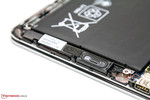
For the Envy Spectre XT 13, HP chose audio components from Beats Audio, a company that specializes in premium headphones. The Spectre XT 13 uses four speakers, two of which are found behind mesh grilles above the keyboard and two of which are located on right and left of the underside. The included software control panel allows for almost limitless sound configurations. We found the sound quality to be very good overall for this type of notebook but we still felt that that the lower frequencies and bass tones were a tiny bit lacking. Those inclined to do so could use either the audio jack or HDMI connector to use higher-end external speaker options.
Battery Life
Power Consumption
In terms of battery life, power consumption is one of the primary factors. During office tasks, the HP Envy Spectre XT 13 consumed between 6.1 and 10.4 Watts, a rather acceptable level for this type of notebook. Under load, power consumption increased to a maximum of 36.6 Watts. This peak consumption is also in line with what one might expect from an ultrabook. Considering the 45 Wh capacity of the included lithium-ion battery, we would expect the Spectre XT 13 to have decent battery runtimes. We will examine this in depth in the next section.
| Off / Standby | |
| Idle | |
| Load |
|
Key:
min: | |
Battery Runtime
In our reviews, we use three different tests to determine the battery runtimes of the systems we evaluate. For the first test, the Battery Eater Classic Test, we use the display’s maximum brightness, activate the Wi-Fi and Bluetooth modules, and, if applicable, turn on the keyboard’s backlight. In this test, the Spectre XT 13 managed a runtime of 92 minutes before requiring external power. In the second test, the Battery Eater Reader’s Test which simulates the reading of a digital document, the display brightness is set to minimum and wireless modules are turned off. In this test, the Spectre lasted over 10 hours. It should be noted that the Reader’s Test is an unrealistic scenario especially considering the glossy screen and low brightness made it almost impossible to read the display’s contents in bright environments.
To test a more realistic scenario, we use our third test, the Wi-Fi Surfing Test. In this test, we set the display brightness to approximately 150 cd/m2 and use an automated script to visit a different website every 40 seconds. In this scenario, the Envy ultrabook managed to run for 5 hours 14 minutes, an acceptable result for the class and size of the battery. While this is short of HP’s battery runtime claim of seven hours, the specific conditions of the test were not specified by the manufacturer.
Verdict
Our review of the HP Envy Spectre XT-2000eg ultrabook left us with mixed feelings. While we were impressed with the sturdy, good-looking aluminum-magnesium alloy case, the well-designed input devices including keyboard backlight, and the performance of the components, the system also is burdened with some negative attributes. These include a mediocre display and an annoyingly loud and insufficient cooling system. The up-to-date port selection and Beats Audio speaker system are nice features but they did not influence the final result very much.
In terms of the aforementioned port selection, we would have liked to see an additional USB 3.0 port or a Thunderbolt connector. Expansion is an additional weak point as the entire underside plate needs to be removed simply to gain access to RAM that is soldered onto the motherboard and the rather expensive mSATA SSD. Throttling was observed during our full load stress test but we did not encounter any issues in daily use.
All in all, the Spectre XT 13 is not a bad ultrabook. Due to its strong points, we gave the notebook a good rating. We hope that HP will learn from its mistakes and rectify the ultrabook’s shortcomings in the future. With at least two strong competitors in this market segment – the Asus Zenbook Prime UX31A and the Apple MacBook Air 13 (Mid-2012) – serious flaws really are not an option for HP going forward.




